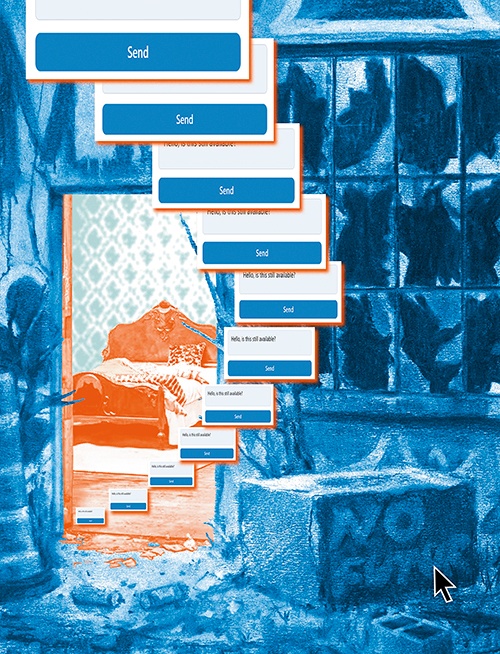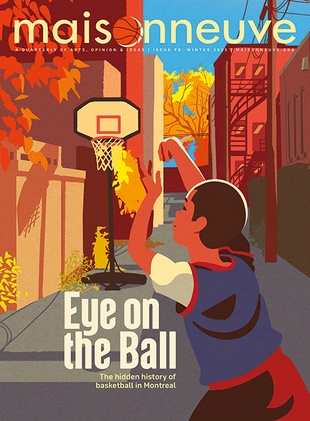 Illustration by Wolfe Girardin Jodoin.
Illustration by Wolfe Girardin Jodoin.
Hydro Not Included
A deluxe bedroom built in the middle of an abandoned factory is an ironic response to Montreal’s housing crisis.
It’s a gloomy April day in Montreal’s Saint-Henri neighbourhood as I walk along the Lachine Canal. Spring officially began three weeks ago, but the leaves have not yet returned to the trees, and most of the garbage that appeared out of the melting snow is yet to be picked up. It’s cold and rainy, and the miserable weather seems a perfect match for the old industrial buildings that line Rue Saint-Patrick, which winds along the southern shore of the canal. The buildings are flat and wide, decrepit, covered in graffiti. Much of the glass that once filled top-floor windows is now broken. Entrances are boarded up, trespass warnings stamped by the city on the wooden blockades. As I move closer to my destination, I feel my phone vibrate with a text: “I am inside. They blocked the main entrance, but I found another way.”
When I reach the corner of Boulevard de la Vérendrye, I stop in front of what looks like the last abandoned building on this stretch of Saint-Patrick. Somehow, it appears to be in even worse shape than the ones that preceded it. This has to be it. I contemplate for a second whether to try to find the entrance myself, or call my host to come get me. Just then, he walks around the corner. We shake hands and he introduces himself as Gabriel Lacombe, an architect by trade and artist in practice. He’s invited me to view the project he spent the last four years creating with his colleague and friend Marc-Antoine Goyette.
I follow Lacombe to the eastern side of the complex and we enter through a broken ground-floor window. Immediately, I’m taken aback by the size of the space. Once the site of a torpedo boat manufacturing plant, the complex, now owned by the city, has been empty for over a decade. The ground is littered with all kinds of industrial waste: wooden planks, metal rods, loose wires. A group of office chairs form a circle in one area with a handful of red Solo cups strewn around them. As we navigate the obstacles on the wet concrete floor, Lacombe tells me that raves were once thrown inside the building. He suspects people have been coming back to party.
We climb a rusty staircase to the second floor and arrive at a room tucked away among the chaos of the abandoned building. The floor suddenly turns to hardwood, the walls covered in white-and-gold damask wallpaper. Matching handcrafted furniture populates each corner of the room, and a skylight shines directly onto a queen bed ready to be slept in. Steps away from the industrial detritus, I find myself in an entire makeshift Victorian-style bedroom. What we are standing in is “Chic Bidonville”—meaning shantytown chic—an installation that Lacombe and Goyette built to express their rage at the increasing lack of affordable housing in their hometown.
As a work of art, “Chic Bidonville” is difficult to define. Lacombe calls it an example of “manœuvre,” an artistic practice developed in Quebec in the nineties, in which space and audience participation are central parts of the work itself. For Lacombe and Goyette, the most important thing about the installation is that people interact with it—and since the work was completed last fall, they have been. Lacombe says that each time he returns to the space there is a new piece of graffiti on the wall, and the bedding has been moved around. He believes unhoused people and urban explorers are using it as a place to relax, and maybe even sleep. A broom that Lacombe left last time he was here stands upright in the corner, evidence that people are actually cleaning and caring for the space. Beside the broom sits a tidy garbage can that someone else must have brought in.
The installation was built with Montreal’s frustrated renters and growing population of unhoused people in mind. Lacombe and Goyette were outraged by the way the city treated unhoused people during the pandemic, when encampments were systematically dismantled despite protests. Since then, more Montrealers have found themselves living on the street. According to data from the Institut national de santé publique du Québec, a provincial public health organization, in 2018 there were 3,149 people visibly experiencing homelessness in Montreal. By the following update in 2022, the number had risen to almost 4,700. It was amidst increased homelessness, rising rent prices and lower vacancy rates that the two artists created the installation: the makeshift apartment acts as both a place of rest for the precariously housed, and a piece of commentary on the lack of affordable housing in the city.
Work on the project began in late 2020, but its conceptual roots can be traced back to the previous year, when Lacombe and Goyette first crossed paths. Lacombe was looking for a change of scenery after completing a Master of Architecture at the University of British Columbia, and Goyette needed an internship to finish his post-grad diploma in design at the Université du Québec à Montréal. They met in Germany, where they worked together on a project led by Constructlab, a construction collective made up of architects, engineers, artists and designers from around the world. The collective attempts to build spaces in a collaborative, experimental, community-engaged manner.
Finding themselves on the same team working to create a Bauhaus-inspired community centre, Lacombe and Goyette quickly hit it off. Both men shared a passion for activism and were eager to use their work to highlight social issues. Upon returning to Quebec, they continued their working relationship and began conceptualizing a project that blurred the line between art and utility, not unlike their work at Constructlab.
In 2020, with the pandemic in full swing, Lacombe and Goyette scouted abandoned buildings in Montreal to find a place for the installation they were planning. Out of a small pool of options, 4000 Rue Saint-Patrick quickly emerged as the best one. It was relatively easy to access, and its location, in the centre of a patch of industrial buildings between the canal and a highway, meant there wasn’t much foot traffic nearby, giving them and any visitors to the room privacy. Lacombe and Goyette also felt that the building exemplified some of the bureaucratic hurdles that stand in the way of efforts to broaden access to affordable housing in Montreal. In 2021, it was the subject of an architectural competition seeking the best suggestion to “revitalize” the space. Plans for an artist hub won the contest, but so far haven’t gone anywhere. While a large building like this might have the potential to provide housing or a community space for Montrealers, inaction has resulted in it sitting empty.
At the outset of Lacombe and Goyette’s work, there were squatters living in the building. Their project “started with the idea of making a living room,” Lacombe explains. He notes that while it seemed local unhoused people were able to find places to rest, comfortable spaces that would enable socialization were lacking. Part of the message woven into the fabric of “Chic Bidonville” is that spaces to live, not just to sleep, need to be part of housing solutions. During the pandemic, the city’s destruction of encampments and temporary sheltering of unhoused people in hotel rooms fuelled the artists’ anger even further. “What the city did, basically, when they destroyed the camps, they destroyed the living space of homeless people to give them some empty and dehumanized spaces that [are similar] to prison cells,” Goyette says.
Lacombe and Goyette began to work on the installation in December 2020. Over the next few months, they spent as much time as they could inside the building, gutting the room in preparation for its transformation. They collected materials for the project through second-hand stores and Facebook Marketplace. Friends would come by and help out when they could, but for the most part “Chic Bidonville” was a two-person job. At one point, the pair even spent a week sleeping inside the derelict building.
After close to a year and a half of cleaning, construction could begin. In an effort to have the installation more closely resemble actual, rentable housing, and thus make it more overtly political, Goyette and Lacombe added a bed. They also wrote a two-page manifesto entitled “Pas besoin de frapper pour entrer chez nous”—no need to knock, just come in. In it, they argue that the housing crisis is no accident, and that what we are experiencing is the culmination of decades of neglect and betrayal from politicians who are selling the souls of their cities to developers at the expense of their citizens. “We have left our cities, our spaces, and our ways of life to the empire of developers,” the manifesto reads in French. “You have imposed your lifeless and soulless architecture on us, the concrete embodiment of our dehumanized way of living together.”
Goyette says that he felt this betrayal firsthand in 2022, when he and his girlfriend were “renovicted” from their Montreal apartment—a process by which landlords are able to evict tenants in order to complete major renovations, which then allow them to raise the price of rent. The experience was the last straw for an already-disillusioned Goyette, who decided to move out of the city and into the Eastern Townships, a region in southeastern Quebec. “I realized with my artist salary that I couldn’t even afford my own city anymore,” Goyette says. “So I’m kind of a refugee in my own city, in my own country. I cannot live where I want to live.”
Lacombe and Goyette worked on “Chic Bidonville” as often as the responsibilities of day jobs and everyday life allowed, and the project took four years to complete. By the fall of 2024, the bulk of it was finished, and the duo decided to take things one step further. In another effort to politicize their work, they listed the room as a rental on Facebook Marketplace for $400 a month: about half the price of a room in a shared apartment in Montreal. The duo say that within a few hours the ad racked up 250 responses from people desperate to find affordable housing. Many of those who responded shared lengthy testimonies about their experiences, and offered to sign the lease without even seeing the room.
For Goyette, the experience was depressing, but vindicating. “The goal of the ad was basically [to prove] the [existence of the housing] crisis. Not so long ago, there was a government that was saying there was no such thing as a housing crisis,” Goyette says, referring to Quebec’s former housing minister Andrée Laforest, who outraged many in 2021 by refusing to classify the lack of affordable housing in the province as a crisis. For many advocates, the province’s governing Coalition Avenir Québec party does not have a good track record when it comes to housing. Also in 2021, Quebec Premier François Legault was accused of trying to downplay the severity of the situation after suggesting that Montrealers could still expect to spend about $500–$600 on rent. The average cost of rent in the city at the time was over $900.
Goyette says the purpose of the ad was to demonstrate the extent to which renters in the city were struggling—not to trick them into believing they had finally found somewhere affordable to live. So, after being inundated with messages, they decided to take the ad down, and responded to all inquiries explaining that it had merely been a stunt for their art piece. Goyette says that some of those who responded to the message thanked them for their work in drawing attention to the issue.
Low rent and strong legal protections for tenants once earned Montreal the reputation of a renter’s paradise, but that reality is now gone. A 2023 study led by researchers from McGill University and the University of Waterloo found that the increasing share of rentals in Montreal owned by financialized landlords, such as private equity firms and institutional investors, was driving rent prices up. Data collected by the Coalition of Housing Committees and Tenants Associations of Quebec found a 27 percent increase in the average cost of rent in Montreal between 2020 and 2024, ten percentage points higher than the rate of inflation over the same period. To top things off, in February 2024 a bill giving landlords the right to refuse lease transfers without justifiable cause was adopted into law in Quebec—effectively stripping tenants of one of the last remaining tools at their disposal to have any control over rent increases.
Avi Friedman, a professor at McGill University’s School of Architecture and an expert in affordable housing, says rising rents and the increased financialization of housing are consistent with a widening wealth gap in Canada. “The housing crisis is reaching a level that makes it extremely dangerous to the fabric of Montreal and Canadian society,” Friedman says. According to him, access to affordable housing is the final barrier before we descend into a Dickensian future of haves and have-nots—and we are blowing through it. “The danger lies in the fact we are about to create a two-tiered society, which is something that nations try so hard to avoid,” he says.
Although politicians in Quebec have signalled efforts in recent years to address the housing crisis, most of these proposed solutions rely on the private sector creating more housing, as opposed to increasing government-subsidized social housing, a solution that is more widely supported by advocates and experts. “We have a big stock of social housing, which releases the pressure, but very [few] initiatives have been taken in recent years to significantly increase that stock,” Friedman explains.
He says that increasing Quebec’s stock of social housing requires sustained, long-term investments. With the province battling a historic deficit amid heightened economic uncertainty, Friedman is not optimistic: “Finding the investment is not easy at all. Unfortunately, I don’t see it [happening].” In Quebec’s 2025 budget plan, released earlier this year, Legault’s government allocates over $300 million over the next five years to improve access to housing. The majority of that money, however, will go toward maintaining the low-cost rentals that already exist in the province, not building more of them.
While public funding for housing remains lacking, the room in the abandoned building on Rue Saint-Patrick embodies an almost palpable irony: Goyette and Lacombe received a $25,000 grant from the Canada Council for the Arts for their project, which technically makes it a publicly funded space.
In January, Goyette and Lacombe removed their wooden barrier from the doorframe of “Chic Bidonville,” officially opening the room to anybody who discovers it. In the next few months, evidence of visitors started to appear in the form of graffiti and boot prints marking the wooden floors. For the artists, all of these interactions with the space become a part of the piece. “It’s kind of a performance,” Lacombe says. “The art piece is not over until, I don’t know, maybe the city decides to destroy it. And if they do, [that destruction is] still gonna be part of the piece, right? We’re creating a story.” (In late spring, after my visit, the installation burned down from what the artists believe was an accident, although the space continues to be explored by visitors.)
After briefly touring the other corners of the abandoned boat factory, Lacombe and I return to the room for one final look. Not knowing the next time he will be back, Lacombe takes another round of the room, straightening out some furniture and dusting off the stack of encyclopedias on the bedside table. In the meantime, I take a closer look at the walls, analyzing the different works of graffiti for clues to the public’s reaction to the space. A small piece in the corner of the room reading “Fuck Landlords” seems to prove that at least one person has been galvanized into a sense of resistance.
On our way out, I notice two laminated pieces of paper sitting on a bench by the door. It’s Goyette and Lacombe’s manifesto—they left a copy here when they finished the installation. In it, they characterize their work in French as a “joyful and ironic response" to our era’s issues, writing that “Chic Bidonville” is “an attempt to bring beauty where there is none, to reclaim what has been lost, to offer a small oasis in the desert of our cities and our hearts.” What follows is a call to action addressed to policymakers, as well as a message for fellow citizens, whom Goyette and Lacombe urge to join them in the fight to overcome what they call a moral crisis.
Finally, they instruct those who would like to use the space to care for it as their own; and that if they want to come in, there isn’t any need to knock. ⁂
Boshko Maric is a freelance journalist based in Montreal. He recently graduated from Carleton University, where he was a recipient of the Susan Cardinal Emerging Reporter Fund. He also works as a researcher for CBC Montreal.





